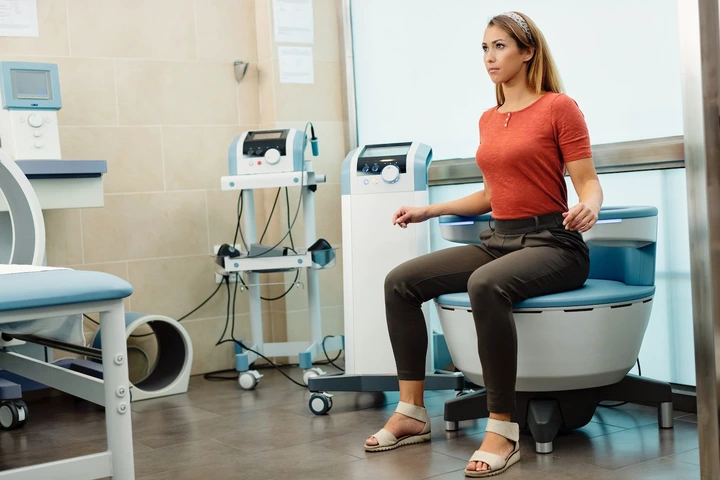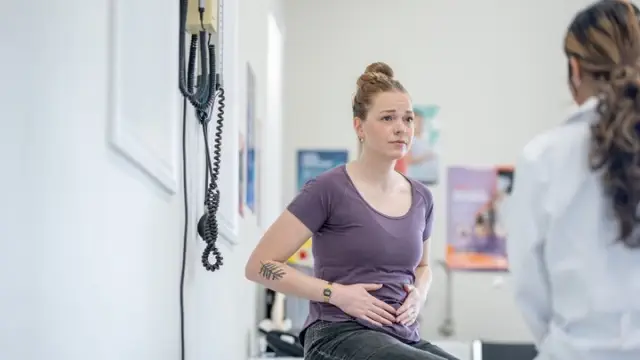In this write-up

View pictures in App save up to 80% data.
Experiencing pelvic floor disorders is not uncommon for women, especially for those who have children. According to UChicago Medicine, one in three women can expect to experience a pelvic floor issue during her lifetime. And one in four women may experience frustrating symptoms like bladder or bowel leakage. But we don’t have to just accept this as our life forever. Pelvic floor therapy can help those with disorders manage their symptoms and restore their pelvic floors.
Here’s all the information you require.
The pelvic floor is a group of muscles and connective tissues located at the base of the pelvis. It plays a crucial role in supporting the pelvic organs, including the bladder, intestines, and uterus in women. These muscles help maintain continence, support sexual function, and aid in childbirth. Additionally, the pelvic floor is involved in core stability and posture. Strengthening and maintaining the health of the pelvic floor is important for overall well-being and can help prevent issues such as incontinence and pelvic pain.

View pictures in App save up to 80% data.
According to the UW School of Medicine and Public Health, our pelvic floor is the bowl-shaped part of our lower abdomen that supports our abdominal organs and helps us properly go to the bathroom. It also helps with sexual satisfaction and is made up of soft tissues and muscles.
Pelvic Floor Conditions
When the pelvic floor, which is a sort of hammock for the bowel, bladder, and uterus, is weakened and damaged, it can cause pelvic floor disorders, according to Columbia Surgery. This may result in pelvic muscles that can’t relax properly to assist in you going to the bathroom, per the Cleveland Clinic.
There are three primary types of disorders.

View pictures in App save up to 80% data.
According to Columbia Surgery, the primary issues affecting the pelvic floor include loss of bowel control, difficulty in stool passage, and organ prolapse, which occurs when pelvic organs shift out of their normal position. Additionally, individuals may experience challenges with urination.
Pregnancy May Cause the Problem

View pictures in App save up to 80% data.
Per the Mayo Clinic, about 50% of people who get pregnant will experience pelvic floor disorders during pregnancy. This is due to the weight of the baby and placenta which can place a strain on the pelvic floor, often leading to problems with urinary incontinence.
According to the Mayo Clinic, some women may experience constipation, which can add extra pressure on the pelvic floor. Additionally, the pelvic bones begin to relax in preparation for childbirth, potentially leading to further complications, as highlighted by the Clinic.
Pregnancy Is Not the Sole Risk Factor

View pictures in App save up to 80% data.
Although pregnancy can exacerbate pelvic floor issues, it’s not the only risk factor. The Mayo Clinic also reported that women who have a history of constipation or connective tissue disorders, those who frequently lift heavy weights, and those who smoke may also be at a higher risk. Per Franciscan Health, men can also deal with pelvic floor disorders, including erectile disfunction.
Signs and indications

View pictures in App save up to 80% data.
Per Johns Hopkins Medicine, some of the symptoms to look out for include bladder issues like leakage or frequently needing to pee, bowel issues like leakage or constipation, pain in the pelvic area, difficulty using tampons, prolapse, and sexual dysfunction.
Diagnosis Process

View pictures in App save up to 80% data.
The Cleveland Clinic has indicated that after discussing your symptoms with your doctor, they may inquire further about your bathroom habits, any pain you experience during intercourse, and your history of pregnancy. Additionally, they may perform rectal and pelvic examinations to assess the condition of your muscles, checking for weakness, spasms, or knots. Further testing may also be conducted to evaluate the functioning of your bladder and bowels.
Hopefully, all of this will assist you in obtaining a diagnosis, enabling you to start treatment if it's needed.
Therapeutic Alternatives

View pictures in App save up to 80% data.
There are several types of pelvic floor therapies that can be used to address the issues. Per Johns Hopkins, options include lifestyle changes (like how you sit), muscle and strength exercises, myofascial massaging, laser therapy, electrical stimulation, and “biofeedback.” The latter uses sensors to look at pelvic floor muscles signals like contractions and relaxations, according to Northwestern Medicine.
It May Help Improve C-Section Scars

View pictures in App save up to 80% data.
According to the Mayo Clinic, vaginal birth “is regarded as the most significant risk factor,” for pelvic floor issues. But people who get C-sections can still consider exploring therapy options. Per Parkview Health, pelvic floor therapy can help break up scar tissue that can form following a C-section. It can also help improve lower back and pelvic pain.
Initiate During Gestation

View pictures in App save up to 80% data.
You don’t have to wait until you give birth to focus on your pelvic floor health. According to Raleigh Gynecology & Wellness, “Many exercises are not only safe but also recommended during pregnancy.” Pelvic floor therapy can help alleviate pain, improve posture, prevent incontinence, and help your body recover faster.
Childbirth Education Classes

View pictures in App save up to 80% data.
For expectant parents, attending birth classes can be highly beneficial for preparing the pelvic floor. According to the Mayo Clinic, the stretching and breathing exercises practiced in these classes can support you during labor by helping your diaphragm and pelvic floor work in harmony. Additionally, incorporating yoga and perineal massage can contribute to the health of the pelvic floor tissues.
Workouts to Try

View pictures in App save up to 80% data.
Lewisville Women’s Care recommends that people focus on their pelvic, hip, and core strength to support their pelvic floor. Per the Mays Cancer Center, this can include doing exercises like the bridge pose, squats, pelvic tilts, and bird dog stretches. Consult with your doctor, especially if you’re pregnant, before adding pelvic floor exercises into your routine.
Pelvic floor exercises

View pictures in App save up to 80% data.
You’ve probably heard that doing kegels can be helpful, but that’s only if they’re done correctly. The Mayo Clinic has a helpful guide to doing proper kegels. Essentially you have to find and isolate the right muscles (so don’t flex your stomach, thighs, or glutes while doing kegels) and repeat three times a day, working up to 10 to 15 kegels per set.
Locate a Service Provider

View pictures in App save up to 80% data.
If you’re experiencing pelvic floor disorder symptoms, or you’re pregnant or just generally concerned about your pelvic floor health, you can speak with your doctor about your potential therapy options. You can also find local pelvic rehab practitioners at pelvicrehab.com.
It won't disappear by itself.

View pictures in App save up to 80% data.
The Cleveland Clinic has highlighted that although pelvic floor disorders can typically be managed effectively, they will not resolve independently without intervention or therapeutic measures. Individuals might experience a delay of several months before they observe any improvement in their symptoms. However, those who remain diligent in their treatment or therapy approaches are likely to notice a positive change over time.










